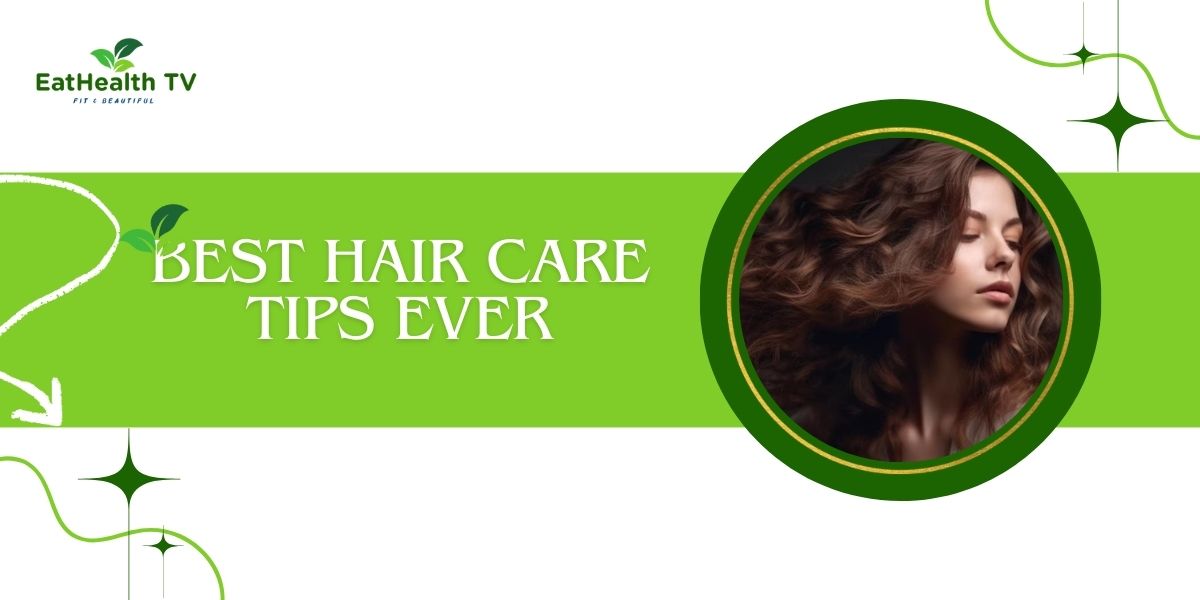Best Hair Care Tips Ever
Discover the Ultimate Hair Secrets for Shiny, Healthy Locks

Best Hair Care Tips Ever: Achieving Healthy and Beautiful Hair
Taking care of your hair can sometimes feel like a full-time job. Between understanding your hair type, finding the right products, and mastering proper techniques, it can be overwhelming. Whether you’re a 12th-grade student or a hair care expert, this comprehensive guide will provide you with the best hair care tips to ensure your hair is always looking its best.
Understanding Your Hair Type
Before diving into specific hair care tips, it’s crucial to understand your hair type. Hair types can be broadly categorized into four types: straight, wavy, curly, and coily. Each type requires different care routines and products.
- Straight Hair: Often looks sleek and shiny but can be prone to oiliness.
- Wavy Hair: Has a natural wave and can be prone to frizz.
- Curly Hair: Defined curls that can range from loose to tight ringlets, often prone to dryness and frizz.
- Coily Hair: Very tight curls or zig-zag patterns, often the driest and most fragile hair type.
Knowing your hair type will help you choose the right products and techniques, ensuring your hair stays healthy and manageable. Just as we know How Do Hairstyles Affect Facial Beauty?
The Fundamentals of Hair Care
- Cleansing
Cleansing your hair is the foundation of any hair care routine. The key is to use the right shampoo and not to wash your hair too often, as this can strip it of its natural oils.
- Shampoo Selection: Choose a shampoo that suits your hair type. For example, if you have oily hair, go for a clarifying shampoo that helps remove excess oil. If you have dry hair, a moisturizing shampoo will help keep your hair hydrated.
- Frequency: Washing your hair too frequently can lead to dryness and scalp irritation. Aim to wash your hair 2-3 times a week, or as needed based on your hair type and lifestyle.
- Conditioning
Conditioning is essential for maintaining moisture and preventing tangles. Always use a conditioner after shampooing, focusing on the mid-lengths and ends of your hair.
- Deep Conditioning: Once a week, use a deep conditioning treatment or hair mask. These products penetrate deeper into the hair shaft, providing extra nourishment and repair.
- Leave-in Conditioner: For added moisture and protection, consider using a leave-in conditioner, especially if you have dry or damaged hair.
- Detangling
Detangling your hair is a crucial step to avoid breakage and split ends.
- Tools: Use a wide-tooth comb or a detangling brush. These tools are gentler on your hair and help prevent breakage.
- Technique: Start detangling from the ends and work your way up to the roots. This method minimizes damage and makes the process easier.
- Drying
Proper drying techniques can significantly impact your hair’s health.
- Air Drying: Whenever possible, let your hair air dry. Excessive heat from blow dryers can cause damage and dryness.
- Heat Protectant: If you need to use a blow dryer, always apply a heat protectant spray to shield your hair from heat damage. Use the dryer on a low heat setting.
Advanced Hair Care Tips
- Scalp Care
Healthy Hair Care starts with a healthy scalp. Scalp care is often overlooked but is essential for maintaining hair growth and overall hair health.
- Exfoliation: Just like your skin, your scalp can benefit from exfoliation. Use a scalp scrub or an exfoliating shampoo once a month to remove dead skin cells and product buildup.
- Massage: Regular scalp massages can stimulate blood flow and promote hair growth. Use your fingertips to massage your scalp for a few minutes during each wash.
- Protective Hairstyles
Protective hairstyles can help reduce hair breakage and retain length, especially for curly and coily hair types.
- Styles: Buns, braids, and twists are great protective styles. They keep your ends tucked away and minimize manipulation.
- Alternating Styles: Avoid keeping the same style for too long, as this can lead to tension and breakage at the roots. Alternate your protective styles regularly.
- Trimming
Regular trims are essential for maintaining healthy hair and preventing split ends.
- Frequency: Trim your hair every 6-8 weeks. Even if you’re growing your hair out, trimming the ends will help keep it healthy and strong.
- Technique: If you’re trimming at home, use sharp hair-cutting scissors. Dull scissors can cause more damage to the hair shaft.
- Heat Styling
While heat styling tools like flat irons and curling wands can help you achieve various looks, they can also cause significant damage if not used properly.
- Heat Protectant: Always use a heat protectant spray or serum before using any heat styling tools. This creates a barrier between your hair and the heat, reducing damage.
- Temperature Control: Use tools with adjustable temperature settings. Fine or damaged hair should be styled at lower temperatures, while thicker hair can handle higher heat.
Nutrition and Hair Health
What you put into your body is just as important as the products you apply to your hair. A balanced diet rich in vitamins and minerals can promote healthy hair growth and prevent hair loss.
- Vitamins and Minerals
- Biotin: Also known as vitamin B7, biotin is crucial for hair growth and strength. It can be found in foods like eggs, nuts, and whole grains.
- Vitamin D: Essential for hair follicle health. Get enough vitamin D through sun exposure or supplements if necessary.
- Iron: Iron deficiency can lead to hair loss. Incorporate iron-rich foods like spinach, red meat, and legumes into your diet.
- Protein
Hair is primarily made of protein, so ensuring you get enough in your diet is vital for maintaining its structure and strength.
- Sources: Include protein-rich foods like lean meats, fish, beans, and dairy in your meals.
- Hydration
Staying hydrated is key to overall health, including the health of your hair. Drink plenty of water throughout the day to keep your hair and scalp hydrated.
Choosing the Right Hair Products
With so many hair products on the market, it can be challenging to know which ones are best for your hair type and needs.
- Shampoos and Conditioners
Choose products that are specifically formulated for your hair type. For example, if you have color-treated hair, use a shampoo and conditioner designed to protect and prolong your color.
- Styling Products
- Mousses and Gels: Great for adding volume and hold, especially for fine or curly hair.
- Serums and Oils: Perfect for adding shine and reducing frizz. Apply a small amount to the ends of your hair to avoid greasiness.
- Hairspray: Use a flexible hold hairspray to keep your style in place without making your hair stiff.
- Natural vs. Chemical Products
There’s a growing trend towards using natural hair products free of sulfates, parabens, and other chemicals. While these can be gentler on your hair, it’s essential to find what works best for you.
- Natural Products: Often contain fewer harsh chemicals and can be more hydrating.
- Chemical Products: Sometimes necessary for specific hair concerns, like dandruff or severe damage. Use them as directed and consider alternating with natural products.
Hair Care Myths Debunked
There are many myths surrounding hair care. Let’s debunk some of the most common ones:
- Myth: You need to brush your hair 100 times a day.
- Truth: Over-brushing can actually cause breakage and damage. Instead, brush your hair gently and only as needed.
- Myth: Cutting your hair makes it grow faster.
- Truth: Trimming your hair doesn’t affect the growth rate, but it does help maintain healthy ends and reduce breakage.
- Myth: You shouldn’t wash your hair every day.
- Truth: This depends on your hair type and lifestyle. While over-washing can strip your hair of natural oils, some people may need to wash their hair daily due to oiliness or other factors.
- Myth: Air drying is always better than blow drying.
- Truth: While air drying is generally gentler, blow drying with the proper techniques and heat protectant can be safe. In fact, leaving your hair wet for too long can sometimes lead to damage.
DIY Hair Treatments
Sometimes, the best treatments can be found in your kitchen. Here are some DIY hair Care treatments that can provide excellent results without breaking the bank.
- Coconut Oil Hair Mask
- Ingredients: Coconut oil
- Instructions: Warm up a small amount of coconut oil and apply it to your hair, focusing on the ends. Leave it on for at least 30 minutes before washing it out with shampoo.
- Avocado and Honey Hair Mask
- Ingredients: 1 ripe avocado, 2 tablespoons honey
- Instructions: Mash the avocado and mix it with honey. Apply the mixture to your hair and leave it on for 20-30 minutes. Rinse and shampoo as usual.
- Apple Cider Vinegar Rinse
- Ingredients: 2 tablespoons apple cider vinegar, 1 cup water
- Instructions: Mix the vinegar with water and pour it over your hair after shampooing. Leave it on for a few minutes before rinsing with cool water. This rinse helps balance your scalp’s pH and adds shine.
- Egg and Olive Oil Treatment
- Ingredients: 1 egg, 2 tablespoons olive oil
- Instructions: Beat the egg and mix it with olive oil. Apply the mixture to your hair and leave it on for 20 minutes. Rinse with cool water and shampoo.
Seasonal Hair Care
Your hair care routine might need adjustments based on the season. Different weather conditions can impact your hair in various ways.
- Summer Hair Care
- Protection: Use a leave-in conditioner with UV protection to shield your hair from sun damage.
- Hydration: Increase the use of moisturizing products to combat dryness caused by sun exposure and chlorine from swimming pools.
- Winter Hair Care
- Moisture: The cold weather can dry out your hair. Use a deep conditioning treatment weekly.
- Avoid Heat: Reduce the use of heat styling tools as much as possible, as indoor heating can already make your hair more prone to dryness.
Professional Hair Care
Sometimes, professional care is necessary to maintain your hair’s health.
- Salon Treatments
- Keratin Treatments: These can help smooth frizz and add shine, making your hair more manageable.
- Olaplex Treatments: Perfect for repairing damage from coloring or heat styling.
- Regular Appointments
- Haircuts: Keep up with regular trims and haircuts to maintain your hair’s health.
- Color Touch-Ups: If you color your hair, regular touch-ups will help maintain the look and health of your hair.
Conclusion
Achieving healthy and beautiful hair is a journey that involves understanding your hair type, choosing the right products, and maintaining a consistent hair care routine. Whether you’re a student just starting to take control of your hair care or an expert looking for advanced tips, the advice in this guide will help you on your way to gorgeous hair.
Remember, the key to great hair is not just the products you use but also how you care for your hair daily. From cleansing and conditioning to proper drying techniques and nutrition, every step plays a crucial role in maintaining your hair’s health and beauty. Stay consistent with your routine, and your hair will thank you!




